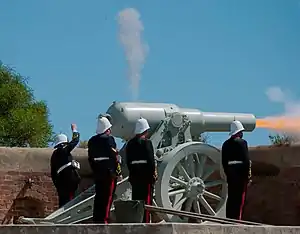RML 64-pounder 64 cwt gun
The RML 64-pounder 64 cwt gun was a Rifled, Muzzle Loading (RML) naval, field or fortification artillery gun manufactured in England in the 19th century,[2] which fired a projectile weighing approximately 64 pounds (29 kg). "64 cwt" refers to the gun's weight rounded up to differentiate it from other "64-pounder" guns.
| RML 64-pounder 64 cwt gun | |
|---|---|
 Fortification mounted MK III gun firing at Fort Glanville Conservation Park, South Australia | |
| Type | Naval gun Fortification gun |
| Place of origin | United Kingdom |
| Service history | |
| In service | 1865–190? |
| Used by | British Empire |
| Production history | |
| Designer | Woolwich Arsenal |
| Designed | 1864 |
| Manufacturer | Woolwich Arsenal Elswick Ordnance Company |
| Variants | Mk I, II, III |
| Specifications | |
| Mass | 64-long-hundredweight (3,300 kg) |
| Length | 9 ft 10 inches[1] |
| Barrel length | 97.5 inches bore |
| Shell | 64 pounds (29 kg)[2] |
| Calibre | 6.3 inches (160 mm) |
| Action | RML |
| Breech | none – muzzle-loading |
| Muzzle velocity | wrought-iron tube : 1,252 feet per second (382 m/s) Mk III steel tube : 1,390 feet per second (420 m/s)[3] |
| Effective firing range | 5,000 yards (4,600 m)[2] |
Description
The calibre of 6.3 inches was chosen to enable it to fire remaining stocks of spherical shells originally made for the obsolete 32 pounder guns if necessary.
Mark I (adopted in 1864) and Mark II (adopted 1866) guns, and Mark III guns made from 1867 – April 1871 had wrought-iron inner "A" tubes surrounded by wrought-iron coils.
Mark III guns made after April 1871 were built with toughened mild steel "A" tubes, and earlier Mark III guns were re-tubed with steel and were classified as a siege gun in land service. Remaining guns with iron tubes were used for sea service.[4]
Rifling of all guns consisted of 3 grooves, with a uniform twist of 1 turn in 40 calibres (i.e. 1 turn in 252 inches).[4]
Ammunition
The gun's standard shell was "common shell", for firing on troops in cover, ships and buildings, weighed 57.4 pounds (26.0 kg) when empty with a bursting charge of 7.1 pounds (3.2 kg). Shrapnel shells could also be fired; a 66.6 pounds (30.2 kg) shell with a 9-ounce (260 g) bursting charge propelling 234 metal balls.[5]
Surviving Examples of Guns

- Mark I, Mark II number 164 and Mark III guns at Fort George, near Inverness, Scotland, UK
- Mark III gun number 294, dated 1867, Nothe Fort, Weymouth, UK
- Mark III gun at Fort Brockhurst, Gosport, UK
- Mark III gun number 17 on board HMS Gannet, Chatham Dockyard, UK
- Two Mark III guns, including no. 318 dated 1867 at Pendennis Castle, Cornwall, UK
- Mark III guns number 462 and 463 at Fort Glanville, Adelaide, South Australia
- Mark III gun number 739, dated 1878, Townsville, Queensland, Australia
- Mark III gun number 742 dated 1878 - ex HMQS Otter (Queensland colonial navy) example displayed in Queens Park Toowoomba, Queensland, Australia
- Two Mark III guns at Fort Lytton Historic Military Precinct, Brisbane, Australia[6]
- Lei Yue Mun Fort's Central Battery, Hong Kong
- 6 guns at Fort Siloso, Singapore including Mark III gun Number 767, dated 1874
- RML 64-pr 64 cwt Mk 3 at Albert Park, Auckland, Auckland, New Zealand

Surviving Examples of Ammunition
- RML 64pdr shell that has been fired, and RML 64 fuse at Fort Lytton Historic Military Precinct, Brisbane, Australia
- RML 64pdr Mark I shell (no fuse) is held in the collection of the Australian War Memorial, Canberra
See also
- RML 64-pounder 71 cwt gun : conversion of SBML 8-inch 65 cwt gun
Notes and references
- http://riv.co.nz/rnza/hist/gun/rifled5.htm
- A Guide to Fort Glanville, South Australia. Semaphore Park, South Australia: The Fort Glanville historical association. 2000.
- 1,252 feet/second firing a 64-pound projectile with 8 pounds R.L.G. gunpowder is quoted for wrought-iron tubed guns in "Treatise on Construction and Manufacture of Service Ordnance, 1879", page 363. 1,390 feet/second firing a 65-pound projectile using 10 pounds R.L.G.4 gunpowder is quoted for Mk III steel tube gun in Table XII in "Text Book of Gunnery 1902".
- Treatise on Construction and Manufacture of Service Ordnance, 1879, pages 292, 261-265
- "The 64pr. 64 cwt gun Mark III". Palmerston Forts Society, Fareham Hampshire U.K. Retrieved 20 January 2009.
- The two 1878 guns are still fired regularly "Gun-firing Re-enactment | Fort Lytton Historic Military Precinct". fortlytton.org.au. Retrieved 13 August 2016.
Bibliography
External links
| Wikimedia Commons has media related to RML 64 pounder 64 cwt Gun. |
- YouTube video showing re-enactment of loading and firing with blank cartridge at Fort Lytton, Queensland
- Handbook for the 64 – pr. R.M.L. gun of 64 cwt., marks I-III land service 1888, 1893, 1900, 1902 at State Library of Victoria
- Diagram of gun on 6-foot parapet platform mounting at Victorian Forts website
- 1916 "The Brisbane Courier" newspaper clipping showing the 64 pounder muzzel loader siege gun,bearing the date 1881, that was on the beach, at Manly (Queensland, Australia) for many years. It may now be one of the surviving guns at Fort Lytton. https://trove.nla.gov.au/newspaper/page/1588925 Here are links to other photos of the same gun https://library-brisbane.ent.sirsidynix.net.au/client/en_AU/search/asset/23652/0 https://library-brisbane.ent.sirsidynix.net.au/client/en_AU/search/asset/23748/0 https://library-brisbane.ent.sirsidynix.net.au/client/en_AU/search/asset/23373/0